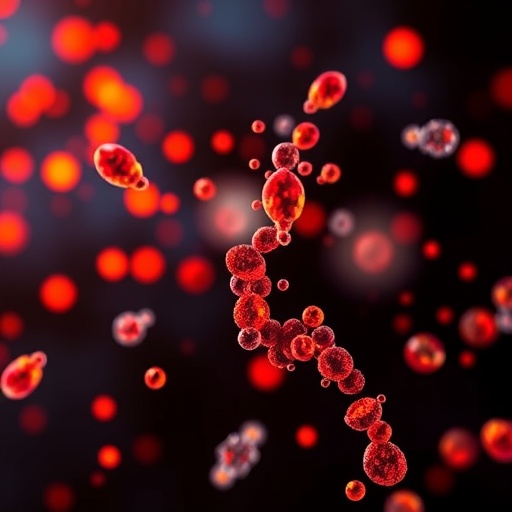PROTECT YOUR DNA WITH QUANTUM TECHNOLOGY
Orgo-Life the new way to the future Advertising by AdpathwayRecent breakthroughs in marine biology have unveiled intricate details regarding the sex-switching mechanisms in juvenile hermaphroditism observed in the silver pomfret, scientifically known as Pampus argenteus. This fascinating species, which inhabits the warm waters of the Indo-Pacific, has become a focal point of research, shedding light on the complex genetic processes that dictate sex determination in fish. A comprehensive study led by Li et al. highlights the role of transcriptome analysis in understanding these mechanisms, providing novel insights that could revolutionize aquaculture practices.
The research team undertook an extensive transcriptomic analysis to identify the genes associated with sex determination in juvenile silver pomfret. They focused on key developmental stages, investigating how environmental factors and genetic predispositions interact to influence whether an individual develops as male, female, or hermaphrodite. This knowledge is particularly vital for aquaculture, where the ability to manipulate these sex-determining mechanisms could enhance fish production efficiency and sustainability.
One of the standout findings of this study is the discovery of specific gene expressions that are significantly upregulated or downregulated during the sex transition process. These variations indicate a complex regulatory system at play, which could also provide clues as to why some individuals may exhibit hermaphroditism as opposed to strictly male or female characteristics. The implications of these findings extend beyond basic science; they hold potential applications in breeding programs designed to optimize yields in aquaculture settings.
The importance of understanding sexual differentiation in fish extends to conservation as well. Overfishing and habitat loss have led to a decline in many fish populations, including the silver pomfret. By deciphering the genetic code of sex determination, conservationists and biologists could better manage breeding programs that promote genetic diversity and population resilience. This could become a pivotal strategy in ensuring the survival of species threatened by anthropogenic pressures.
Moreover, the concept of environmental sex determination (ESD) is a critical aspect of this research. Silver pomfrets are believed to exhibit plasticity in their sex determination processes, allowing their sex to be influenced by environmental conditions such as temperature and social interactions. This adaptability can be advantageous in fluctuating ecological landscapes, presenting an opportunity for these fish to effectively manage their population dynamics.
The researchers utilized advanced bioinformatics tools to analyze the large datasets obtained from transcriptomic studies. By comparing gene expression profiles across various developmental stages, they were able to pinpoint genes that function as master regulators in the sex determination pathway. These insights could pave the way for the development of genetic markers, which may expedite breeding programs aimed at enhancing desirable traits in aquaculture.
Understanding the molecular pathways that govern sex determination in Pampus argenteus not only adds to our fundamental comprehension of fish biology but also raises intriguing questions about evolutionary adaptations. For instance, how do these mechanisms compare across other species exhibiting hermaphroditism? Are there shared evolutionary pressures that drive similar genetic adaptations? These questions open new avenues for future investigations in evolutionary biology and comparative genomics.
The implications of the findings extend to the culinary world as well. As silver pomfret is a cherished delicacy in various cuisines, understanding its biology and reproductive mechanisms can lead to more sustainable fishing practices and ensure food security. The insights gleaned from this research could inform policies that promote responsible harvesting, which is crucial for maintaining healthy fish populations in marine ecosystems.
As researchers continue to delve deeper into the genetic underpinnings of hermaphroditism in silver pomfret, the study’s findings may enlighten other areas of ichthyology. The genetic frameworks discovered could serve as models for dissecting similar phenomena in related species, contributing to a broader understanding of sexual differentiation across the animal kingdom.
Ultimately, this pioneering research undertaken by Li et al. underscores the successful integration of transcriptomic analysis in marine biology. Their work stands as a testament to the potential of genomic studies to reveal previously obscured biological processes, fostering a deeper appreciation for the complexities of life in our oceans. It also emphasizes the continued need for interdisciplinary approaches that merge genetics, ecology, and conservation efforts to sustainably manage and protect marine biodiversity.
Li et al.’s study is poised to spark interest not only within academic circles but also among policymakers, aquaculture practitioners, and conservationists. The intersection of science and practical application is where true progress lies, and this research exemplifies the crucial role of fundamental science in addressing real-world challenges. In a rapidly changing world, harnessing the power of genetic research may indeed be key to safeguarding our planet’s marine resources for future generations.
The sex-switching mechanism of Pampus argenteus presents a fascinating lens through which to explore broader questions regarding adaptability and resilience in the face of environmental change. As researchers uncover the layers of complexity within these marine organisms, we are reminded of the intricate ties that bind life on our planet, inspiring actions that respect and preserve this precious biodiversity for years to come.
Subject of Research: Transcriptome analysis of juvenile hermaphroditism in silver pomfret
Article Title: Transcriptome analysis reveals the sex-switching mechanism of juvenile hermaphroditism in silver pomfret (Pampus argenteus)
Article References:
Li, Y., Hu, J., Wang, C. et al. Transcriptome analysis reveals the sex-switching mechanism of juvenile hermaphroditism in silver pomfret (Pampus argenteus). Biol Sex Differ 16, 51 (2025). https://doi.org/10.1186/s13293-025-00736-1
Image Credits: AI Generated
DOI:
Keywords: Transcriptome analysis, juvenile hermaphroditism, silver pomfret, Pampus argenteus, sex determination, aquaculture, genetics, environmental sex determination, evolutionary biology, conservation.
Tags: aquaculture practices and fish productioncomplex regulatory systems in fish geneticsdevelopmental stages of silver pomfretenvironmental factors influencing sex developmentgene expressions in sex transitiongenetic processes in sex determinationIndo-Pacific marine species researchnovel insights in aquaculture researchsex-switching mechanisms in fishsilver pomfret juvenile hermaphroditismsustainable fish farming techniquestranscriptome analysis in marine biology


 5 hours ago
6
5 hours ago
6





















 English (US) ·
English (US) ·  French (CA) ·
French (CA) ·